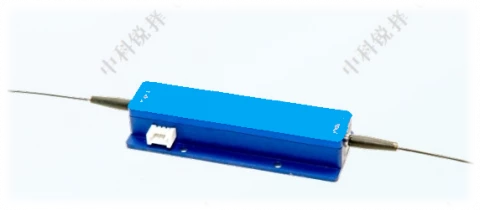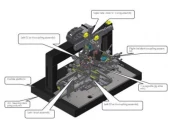Description
The CSRayzer Fiber-Coupled PPLN Waveguide Device is a high-performance frequency conversion module engineered for efficient second harmonic generation (SHG) applications. Utilizing periodically poled lithium niobate (PPLN) waveguide technology, it significantly enhances nonlinear optical conversion efficiency compared to bulk PPLN crystals. Designed with a robust, compact fiber-coupled package, it ensures long-term stability and ease of integration into optical systems.
This device accepts PM1550 fiber input at 1560 nm and converts it to 780 nm via SHG with high conversion efficiency, delivering output power up to 2 W. It supports both fiber-coupled output and free-space configurations, making it suitable for a range of high-precision photonic applications. Advanced packaging techniques allow the device to handle pump powers up to 5 W while maintaining excellent thermal stability and polarization extinction ratio (≥18 dB).
Integrated with a TEC and 4-pin electrical interface for temperature control and monitoring, the device ensures consistent performance over a wide operating temperature range of -20°C to +70°C. Ideal for quantum optics, precision metrology, and high-resolution spectroscopy, this waveguide module delivers exceptional efficiency and reliability.
Fiber Coupled PPLN Waveguide Device for Quautum Optics
Specifications
| Coupling Platform Modules: | Six-axis alignment system, Planar waveguide carrier, Vision module, UV curing module, Pressure sensing system, Stereo microscope module, Extinction ration tester, Software |
|---|---|
| Extinction Ratio Wavelength Range: | 780 – 1560 nm |
| Extinction Ratio Measurement Range: | 1 – 50 dB |
| Pump Input Fiber Type: | PM1550 |
| Electrical Interface: | Not Specified |
| Output Fiber Type: | PM780HP |
| Pump Input Power @1560nm: | 5 W |
| Output Power @780nm: | 2 W |
| Electrical Interface: | 4Pin |
| Working Temperature: | -20 to 70 ℃ |
| Polarization Extinction Ratio: | ≥18 dB |
| TEC Current: | 1.6 A |
| NTC Impedance @25℃: | 10 kΩ |
| Operating Temperature Range: | -20 to +70 °C |
| Storage Temperature Range: | 15 to 30 °C |
Features
- High Conversion Efficiency: PPLN waveguide structure enables superior SHG efficiency
- Compact Fiber-Coupled Package: Integrated fiber input and output for simplified system integration
- High Output Power: Delivers up to 2 W at 780 nm with 5 W pump input
- Thermal Control: Integrated TEC and NTC sensor for stable operation
- Polarization Maintaining Design: Ensures stable output with ≥18 dB PER
- Wide Operating Temperature: Performs reliably from -20°C to +70°C
- Custom Output Options: Supports fiber or free-space output configurations
Applications
- Quantum Optics: Efficient frequency doubling for quantum communication systems
- High-Resolution Spectroscopy: Narrow linewidth output for precise optical analysis
- Laser Seeding and Pumping: Ideal for wavelength conversion in laser setups
- Optical Metrology: Stable output for interferometry and precision measurement
- Biomedical Imaging: Supports nonlinear optical techniques such as SHG microscopy
Frequently Asked Questions
What is the main advantage of using a PPLN waveguide structure over a traditional bulk crystal?
Can the output be configured as free-space instead of fiber-coupled?
What is the recommended maximum input power at 1560 nm?
How is temperature stability maintained during operation?
What applications are best suited for this frequency conversion module?
Similar Products
Your inquiry has been received.
Create an account by adding a password
Why create an account?
- Auto-complete inquiry forms
- View and manage all your past messages
- Save products to your favorites
- Close your account anytime — no hassle

